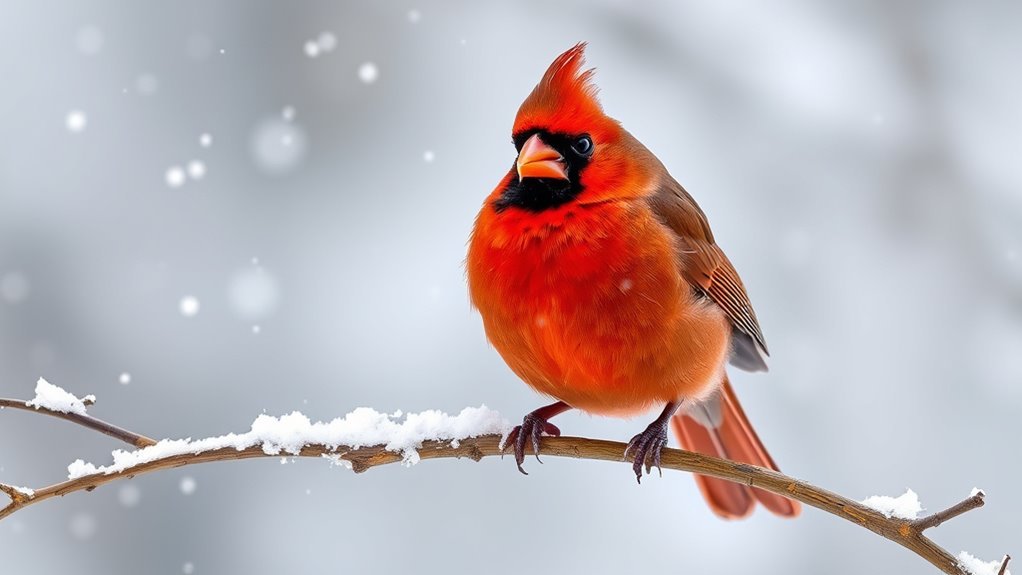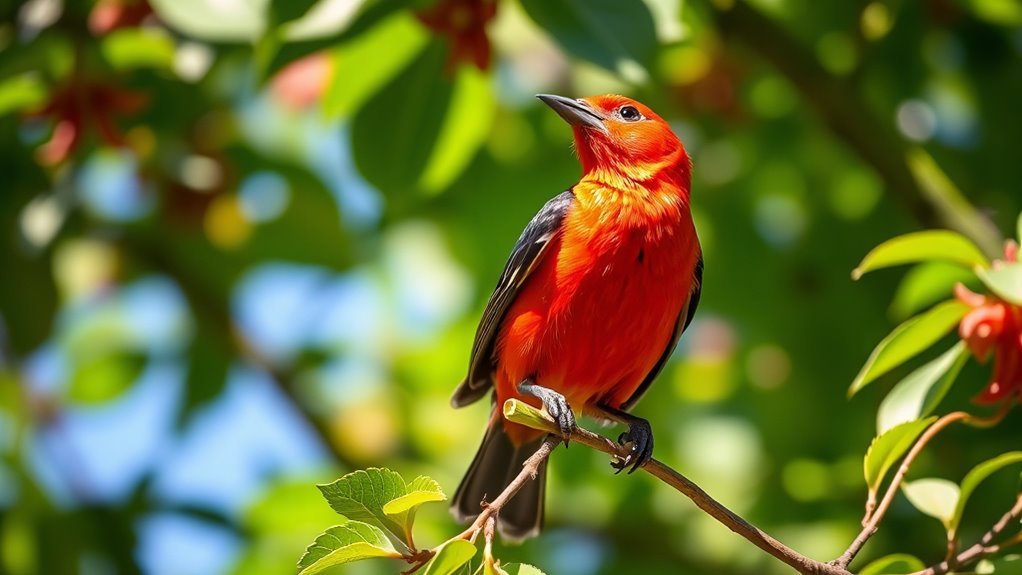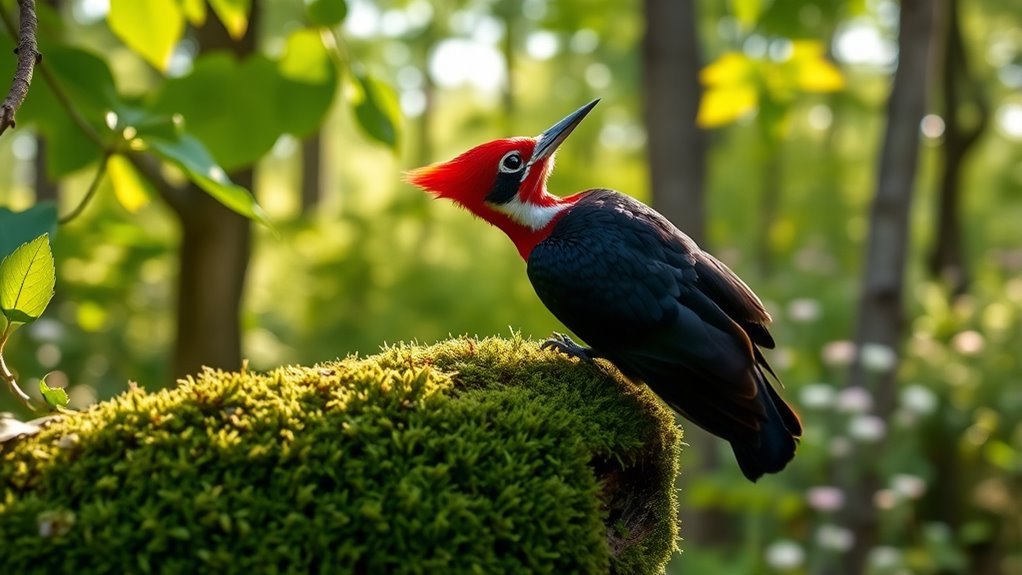Pictures of Red-Headed Birds Found in Minnesota
When you see red-headed birds in Minnesota, you will find a variety of striking species that enrich the state's bird population. The Northern Cardinal stands out with its vivid color, while the Red-headed Woodpecker shows unique feeding habits. Each bird has a special role in nature, but they also face challenges when competing for food and shelter. Understanding these interactions can deepen our appreciation for these vibrant birds.
Key Takeaways
- The Red-headed Woodpecker is a notable red-headed bird recognizable by its bright red head in Minnesota's woodlands and grasslands.
- Male House Finches exhibit red and brown feathers, making them a colorful presence in urban gardens across Minnesota.
- The Scarlet Tanager features vivid red feathers with black wings, visible during migration in Minnesota's deciduous forests.
- Male Pine Grosbeaks flaunt bright crimson feathers against snowy backdrops, often foraging in higher trees during winter months.
- Pictures of these red-headed birds can showcase their distinctive features and habitats in Minnesota's diverse ecosystems.
Northern Cardinal: The Iconic Red Songbird

The Northern Cardinal stands out with its bright red color and is widely recognized in North America.
These songbirds sing beautiful melodies that echo through their homes. They like to live in thick bushes, woodlands, and gardens. These places help them hide from predators while they search for seeds and fruits.
Male Cardinals defend their territory with strong body language and song.
Female Cardinals focus on raising their young in hidden nests. Watching their behaviors can reveal their social interactions and way of communicating.
When you see these birds, they bring vibrancy and life to your surroundings, deepening your appreciation for nature.
Red-headed Woodpecker: A Striking Forager
You can see the Red-headed Woodpecker in Minnesota's woodlands and grasslands.
This bird stands out with its bright red head. It searches for food by flying from tree to tree, looking for insects and acorns. Its pecking shows how it adapts to different environments.
For nesting, it digs holes in dead trees, showing its skill in woodworking. Watching these birds can increase your appreciation for their importance in nature.
These moments connect you to Minnesota's rich wildlife.
House Finch: Colorful Companion of Urban Gardens

The House Finch is a colorful bird found in urban gardens and neighborhoods across Minnesota. Male House Finches have bright red and brown feathers that add beauty to gardens.
These birds enjoy eating seeds, fruits, and nectar, making them important for pollination.
If you're working on your urban garden, inviting House Finches can improve your space. They're social birds that often gather in small groups, creating a lively environment.
By planting a mix of native plants, you can attract House Finches, fostering a balanced ecosystem that benefits both your garden and the birds.
Enjoy watching these cheerful companions as they enhance your gardening experience.
Pine Grosbeak: A Winter Delight
The Pine Grosbeak is a charming bird found in Minnesota during winter. These birds thrive in coniferous forests and add color to snowy landscapes.
- Male Pine Grosbeaks have bright crimson feathers that stand out against the white snow.
- They eat berries and seeds, often found searching for food high in the trees.
- Their friendly nature allows them to gather in flocks, providing a warm sight in the cold season.
Observing Pine Grosbeaks helps you recognize their role in nature. Watching them in their habitat sheds light on the balance of winter wildlife in Minnesota.
Enjoy the beauty and serenity these birds bring to the winter months.
Scarlet Tanager: A Colorful Summer Visitor

As winter ends and spring begins in Minnesota, the Scarlet Tanager appears as a bright summer visitor.
These birds boast vivid red feathers paired with black wings, making them a remarkable sight during their migration. They typically inhabit deciduous forests, where they move gracefully among the branches, their cheerful songs filling the air on warm days.
The male's bright colors help attract females, playing a key role in mate selection. When the tanagers arrive, they bring excitement to birdwatchers and nature lovers who appreciate their short-lived beauty.
Watching the Scarlet Tanager connects people to Minnesota's natural rhythms.
Frequently Asked Questions
What Habitats Do Red-Headed Birds Prefer in Minnesota?
Red-headed birds prefer forest and wetland habitats in Minnesota. They thrive in thick vegetation, where they find insects and seeds. These environments support their need for food and shelter, allowing them to connect with nature.
When Is the Best Time to Spot These Birds?
To spot red-headed birds, visit during spring and early summer. These seasons are best for viewing. Mornings and late afternoons provide excellent conditions to see their bright colors and lively behavior. Pay attention to these times for the best experience.
Do Red-Headed Birds Migrate From Minnesota?
Yes, red-headed birds migrate from Minnesota. These birds leave Minnesota for warmer areas during the winter season. Watching their migration can help you connect with nature and enjoy these amazing birds.
What Food Attracts Red-Headed Birds to My Backyard?
To attract red-headed birds to your backyard, set up bird feeders with a mix of seeds, such as sunflower and milo. These seeds match their eating habits and make your garden more inviting. Enjoy watching these colorful birds visit your space!
How Can I Identify Red-Headed Birds by Their Calls?
To identify red-headed birds, listen carefully to their distinct calls. Pay attention to the pitch, rhythm, and frequency of each sound. Learning these features can improve your birdwatching experience and strengthen your connection to nature.

Hello, I’m Amelia White, the founder of birdsfanatic.com. As a lifelong bird enthusiast and spiritual seeker, I’ve always been fascinated by the mystical connections between birds and the human experience. On this site, I share my knowledge and insights into the symbolic meanings and spiritual significance of various bird species, exploring their roles in mythology, folklore, and cultural traditions. Join me on this journey into the world of birds, where we’ll discover the hidden wisdom and guidance that these magnificent creatures have to offer.







